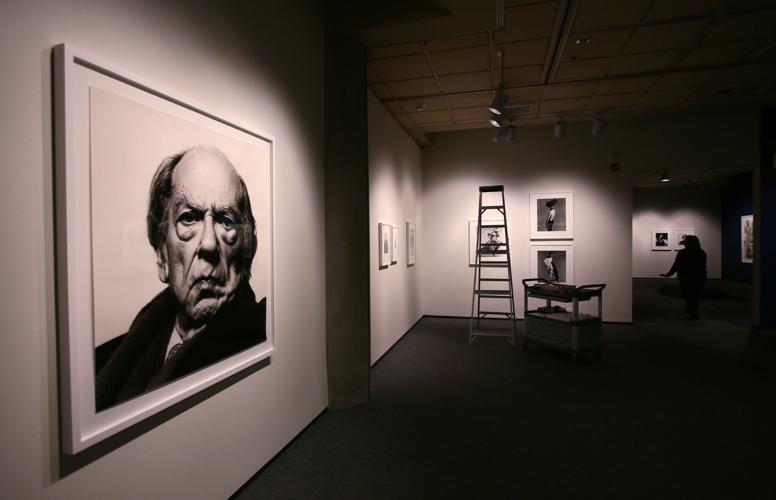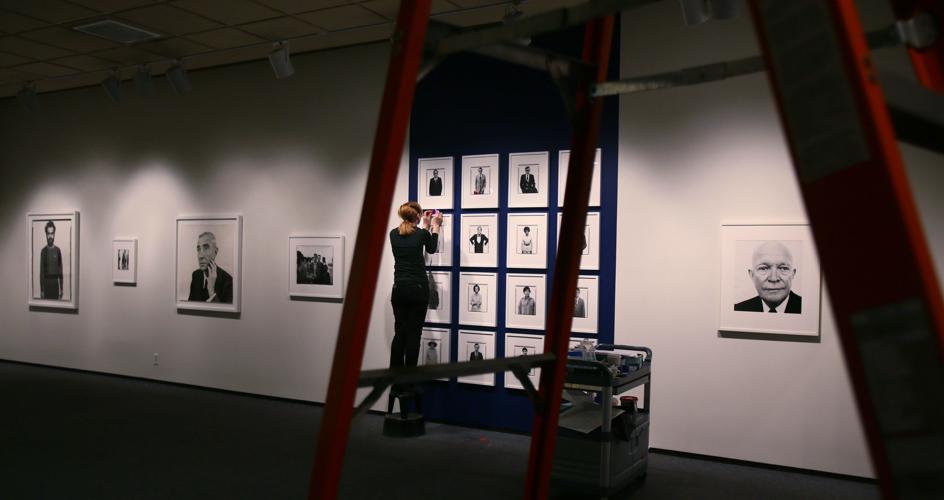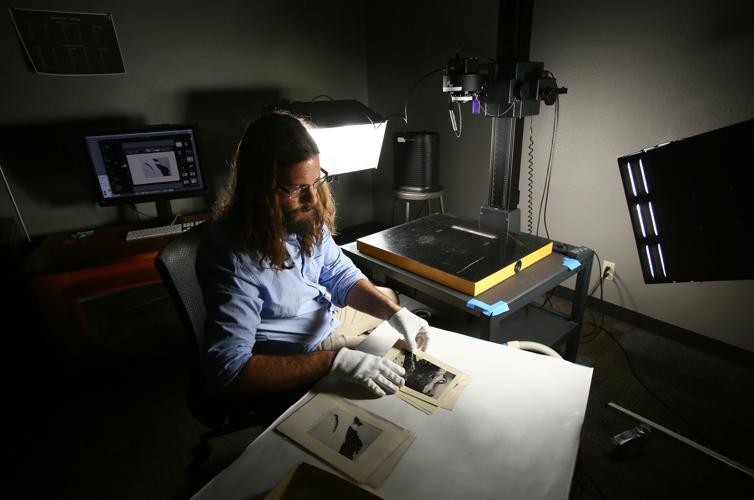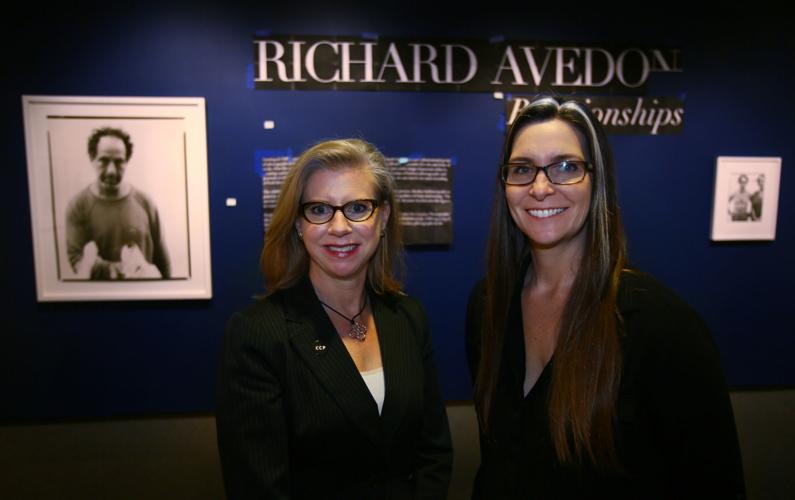“Was it worth it?”
That’s the question that Anne Breckenridge Barrett, director of the Center for Creative Photography, asks herself when she views Richard Avedon’s 1957 portrait of the Duke and Duchess of Windsor.
Deeply furrowed brows, clusters of wrinkles around the eyes, deep creases in Wallis Simpson’s neck, pained expressions and an overall sense of weariness evoke the question of whether King Edward III’s abdication from the throne of the United Kingdom to marry Simpson was worth it.
Avedon’s photos, which often stimulate such questions, enable the viewer to “dwell,” to lose themselves in a photo, says Becky Senf, the center’s chief curator.
The richly detailed photographs enable an up-close, intimate view of the subject: You can visually feel folds of the skin, bristly eyebrows, delicate lips. You meet the subject personally.

“Sir Isaiah Berlin” by Richard Avedon is one of the portraits in the new show at the UA’s Center for Creative Photography.
“He (Avedon) was fascinated by photography’s capacity for suggesting the personality and evoking the life of his subjects,” says the Richard Avedon Foundation website. “He registered poses, attitudes, hairstyles, clothing and accessories as vital, revelatory elements of an image.”
Avedon’s signature portrait style — plain, creamy backgrounds creating negative space that draw attention to each attribute of the subject in the frame, which is defined by the black borders of the negative —conjures an understanding of the personalities and lives of his subjects.
Senf curated the center’s exhibition “Richard Avedon: Relationships,” which opens Saturday, Dec. 15. The exhibit presents 80 Avedon images from the center’s holdings, including large-scale prints, and explores Avedon’s approach to photographing people.
It is an amazing, world-class exhibition, says Breckenridge Barrett.
Avedon originally worked with former center director James Enyeart to place more than 400 significant photographs at the center from 1989 through 2004.
Complemented by select purchases, the collection now has 456 works that span Avedon’s career chronologically and by subject. The center also houses archival materials, such as correspondence, contact sheets, engraver’s prints and a Louis Vuitton case adapted for carrying camera equipment.
This is the third exhibition of Avedon’s work and the first in more than 10 years at the center’s Tucson gallery.
Avedon, who lived from 1923 to 2004, blurred the line between “art” and “commercial” photography.
He honed his skills in the U.S. Merchant Marines and the Design Laboratory of the New School for Social Research and began working as a freelance photographer at age 22, primarily for Harper’s Bazaar, according to the foundation. Denied the use of a studio by the magazine, he photographed models and fashions in unconventional settings — on the streets, nightclubs, the beach and at other uncommon locations.
A pair of fashion photographs of Suzy Parker made in Parisian venues in the “Relationships” exhibit show Avedon’s out-of-the studio work.
He became lead photographer for Harper’s, created portraits for Life and Look magazines, and worked for Vogue for more than 20 years.
“In 1992, Avedon became the first staff photographer at The New Yorker, and his portraiture helped redefine the aesthetic of the magazine,” says the foundation. His brand-defining advertising campaigns included Calvin Klein, Revlon and Versace.
He is also known for his portraiture of the American civil rights movement, the Vietnam War and “The Family,” 69 portraits of the politically, economically and culturally powerful made for Rolling Stone magazine in 1976.
Sixteen of the portraits from “The Family” body of work are in the exhibit. The center encourages the viewer to envision what 69 portraits of America’s influencers would look like today. It is also a fun personal challenge see how many you recognize.

Lynn Richards, exhibition specialist, touches up paint on the wall between prints at the Richard Avedon exhibit.
From 1979 to 1985, he worked extensively on a commission from the Amon Carter Museum of American Art, which produced the show and book “In the American West.”
The center’s exhibit explores Avedon’s relationships on three levels, says Senf.
First, multiple photographs of the same person show the qualities of the character, or qualities of subject and Avedon’s relationship.
Two portraits of American novelist Truman Capote, with whom Avedon collaborated on a book and Avedon’s first book, “Observations,” are prime examples. An ethereal image features Capote as a young, bare-chested man, in an open, sensual pose, while the second is a 50-year-old Capote with puffy eyes, thinning hair and age spots on his forehead. The sensuality is gone.
The second relationship theme is the way Avedon uses the figures to convey relationships, not the individuals, says Senf.
A double portrait of child-development expert Dr. Benjamin Spock and his wife, Jane, captures a tender embrace. You don’t see many details of the individuals — you can’t even see Jane’s entire face. What you see is their relationship and pure affection.
A nearby image of Marilyn Monroe and Arthur Miller is a telling contrast of relationships.
The third relationship explored in the exhibit is between Avedon and the center.
Visitors can view a 4½-minute video of Avedon from the February 1989 opening of the center’s building, when he announced his intent to place his archive at the center. IPads will scroll through images of all 456 Avedon photographs in the center’s collection, says Senf.
Some of the correspondence between Avedon and Enyeart and other center staff members will also be on display.
The “Relationships” exhibit continues until May 15.

Anne Breckenridge Barrett, left, director of the Center for Creative Photography at the University of Arizona, left, and Becky Senf, chief curator, with the Richard Avedon exhibit,

Dana Hemmenway, senior photograph conservator, checks special fabric tabs used for mounting that are attached to the back of a Richard Avedon print of artist Francis Bacon at the University of Arizona’s Center for Creative Photography. The Bacon print is not in the current exhibition.

JP Westenskow, digital-imaging technician, prepares images to be photographed on a copy stand using an 80 megapixel 6x7 digital camera at the Center for Creative Photography. Digitizing a single image can take half a day.









